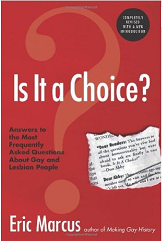
Eric Marcus’ book was a pivotal turning point in my beliefs about homosexuality. Before reading the book, I believed homosexuality was a sin. After reading the book, not only did I no longer view gay people as sinners, I developed a passion for supporting and affirming the LGBT community. And this change is rooted just as deeply in my Christian convictions.
Is It a Choice? is set up in chapters that address a variety of topics related to the gay community, from “Coming Out / Going Public” and “Sex” to “Religion” and “Work and the Military.” The chapters are arranged in a question/answer format, which I found especially helpful, given my own plethora of doubts and questions about what it means to be gay and what it is like to go through life as a gay person. Marcus is himself gay, and the book reveals many of his own personal experiences. At first, he was reluctant to identify as a gay man because of prejudice from heterosexuals and because of a fear of being shamed and rejected by society. He relates an incident where a friend of his said that she would not want to be around someone who was gay. Unknown to her, both Marcus and another friend of theirs—both present—were gay. Eventually Marcus overcame his fear and became comfortable with who he is, and throughout the book, he encourages others to become comfortable with who they are.
One effective method Marcus uses to make his point is by frequently inviting you to put yourself in a gay person’s shoes. He paints a picture of a situation gay people commonly face, so you can see what it would be like if the person caught in the situation were you. For example, in addressing the common complaint, “Why do gay people have to be so public about it? Why do they have to flaunt it?” he points out that when heterosexual couples share kisses or tender caresses in public, it is considered “normal” in most Western cultures, so it is inconsistent, even hypocritical, to consider the same behavior as “flaunting” when same-sex couples do it. This type of turn-the-tables questioning made me realize the absurdity of many common objections to gay life, and the personal stories he shares made me see the issue from a new perspective—a perspective which later became my own.
The simple question/answer format, paired with Marcus’ down-to-earth tone, began to chip away at my beliefs that homosexuality was a sin. The points he brought up were so clear, logical, and thought-provoking, I was forced to reevaluate what I had been taught. For example, when answering the question, “Do animals other than humans engage in homosexual behavior?” he cited numerous examples and added, “No one has yet suggested that this is the result of a passive father and a domineering mother.” That simple statement alone forced me to reevaluate what I “knew” about homosexuality and its origins. Perhaps there was some biological foundation for it that had nothing to do with parent-child relationships.
This combination of rational thought and a passionate recounting of personal stories and experiences, whether his own or from others he’s met along the way, was what made me see the sense in believing homosexuality is anything but a sin.
But the main aspect of this book that challenged me to change my views was the way in which Marcus portrayed LGBT people as really not that different from heterosexuals. There are just too many basic commonalities: men and women of both orientations can have widely varying degrees of masculinity and femininity, each may struggle to find a date (here, he pokes fun at the image of gays as “sex machines”), and people of either orientation can possess a fierce and healthy love for their partners and children. At the same time, he debunks stereotypical myths about gay people, like the idea that gays always have great fashion sense or have many sexual partners. Obviously not true in every case. Questions along the lines of “How would you feel if you, as a heterosexual, were told you had to be gay?” struck me deeply and made me reconsider my perception of the gay community. His book showed me gays and lesbians are as human and as normal and as natural as heterosexuals.
Although this book is geared toward helping people better understand gay and lesbian people, Marcus offered a brief definition of bisexual, transsexual, and transgender—which I found helpful as someone who does not know much about the LGBT community. And the resources he listed throughout his book will also prove helpful for gays or families and friends of gays—resources like PFLAG and other websites and organizations that provide further help for the issues he brings up.
He gives plenty of advice on what to do if your child comes out as gay, how to come out if you are gay, and what limitations gays experience in the outside world—like the lack of the right to marry, or a fear of being intimate in public. His book is an introduction to what it means to be gay, how to react to gays, how to better understand gays, and what some of the basic issues related to homosexuality are within our culture.
What I appreciated as I read the book was not just the new knowledge I was gaining, but also Marcus’ respectful, passionate, and honest approach. Although I could tell at times he was frustrated with heterosexuals because of their narrow-mindedness and the way they strove to hinder progress for gays (such as gay marriage), he did not come off as condemning—something that would have hardened me against his point of view. He was genuine and had a good sense of humor, both of which made it easy for me to lower my defenses and see life from his point of view.
If you’ve known for a while you are gay, Is It a Choice? may not provide much new information for you, as it mostly covers basic issues. It is also not the best place to look for an argument on why being gay is okay (although it will provide thoughts to start getting your mental gears turning on this subject). It does successfully demonstrate why there is nothing wrong with being gay, but from a Christian perspective, the arguments are not sufficiently convincing. This may be because the book is not written from a religious perspective, although it does touch on religious issues at points.
But I highly recommend this book to anyone who is struggling with how to view homosexuality or who would like to understand what gays typically experience. It would also be a great book for those who suspect they might be gay or have just recently accepted they are gay, but who don’t know much about what that means.
This is the perfect book for trying to see the world through new eyes—gay and lesbian eyes. It changed my life and how I now view the lives of LGBT people I come in contact with. My hope is it will do the same for others.
[box type=”bio”]

REBECCA SCHARPF is a 21-year-old college senior at Biola University, working to get her BA in English, with an emphasis in Writing. She is just now trying to set foot in the publishing world, and is enjoying the journey. She also has a deep passion for the LGBT community and LGBT rights.
[/box]


